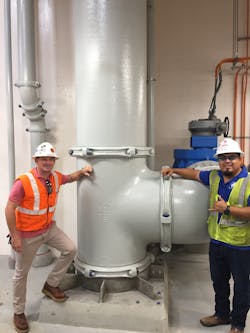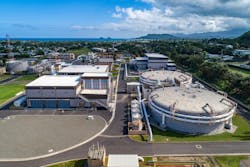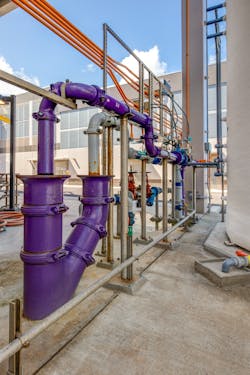Wastewater Treatment Plant Upgrade: Stemming the Tide
Jonathan Leitch is water and wastewater territory manager for Victaulic. Wayne Biery is project sales manager and director for Victaulic. Leitch can be reached at [email protected] and Biery can be reached at [email protected].
undefinedThe city and county of Honolulu, Hawaii, embarked on an extensive wastewater facility expansion and improvement project to reduce the frequency and impact of sewer overflow events. The impetus for the project was a consent decree issued by the U.S. EPA to the Kailua Regional Wastewater Treatment Plant (KRWWTP).
Built in 1965 to serve the town of Kailua, the facility was receiving wastewater from 26 pump stations and two preliminary treatment facilities and providing treatment service for the Koolaupoko District and the areas of Ahuimanu, Kaneohe, Kailua, Aikahi Park, Maunawili, Kailua Heights, Enchanted Lake and Lanikai at the time the update was mandated. The EPA consent decree outlined the requirements for new facilities and identified upgrades that needed to be made to the existing plant.
The project had several significant components, including a 3-mile long and 10-foot-diameter gravity sewer tunnel connecting the Kailua facility to the Kaneohe Wastewater Pretreatment Facility to increase wastewater conveyance and storage capacity. This part of the project featured a deep 45 million gallon per day (mgd) 40,000-square-foot tunnel influent pump station (TIPS), designed by Brown and Caldwell, to lift the wastewater to the surface for treatment. The work scope also included two additional buildings, a 12,000-square-foot headworks facility and a 10,000-square-foot generator building.
This upgrade and construction project, budgeted at $375 million, was the largest wastewater treatment system enhancement program ever undertaken by Honolulu and would require cooperation and collaboration of experienced project partners.
By engaging with the owner and engineers at the outset, Victaulic understood the requirements and goals of the project and began contributing valuable engineering input. This resulted in providing value through a grooved build strategy that supported labor savings during construction and will minimize maintenance costs over the long-term life of the facility.
Tackling Project Challenges
Meeting the proposed schedule is a challenge with nearly every construction project, and few large-scale projects escape unscathed. KRWWTP was no exception. The first project delay occurred nearly at the outset, resulting from challenges encountered while installing the gravity sewer tunnel by the Phase I tunnel contractor. Since the tunnel had to be completed before work could begin on the TIPS, Hensel Phelps, the contractor responsible for installing the building’s mechanical process piping, began its portion of the project several months behind schedule.
Hensel Phelps had other challenges to manage in addition to the schedule. The wastewater treatment plant had to remain in service while the expansion took place, and the piping work the contractor carried out had to be executed in a confined area where other construction activities also were underway. Since Hawaii is an island, there were logistical concerns as well. To get the TIPS completed on time, it was imperative that the products for the piping system arrived at the worksite as planned and were installed as quickly and safely as possible.
These considerations all came to bear on product selection as well as the joining method that would be used to install the piping in the TIPS, Headworks and the Generator Building.
Working in conjunction with Hensel Phelps, Victaulic experts provided a grooved building strategy that would deliver value by using products which could be installed easily, providing the required performance without introducing the safety hazards typically associated with traditional joining or building methodologies. The decision to use this approach opened the door to expand the value of the grooved methodology to the primary sludge, effluence reuse water, process air and grit systems. For these systems, the grooved solutions utilized a wide variety of Victaulic products, including flange adapters, ring couplings, rigid couplings and Vic-Press products in addition to the plain end HDPE couplings. The products were installed in the KRWWTP facilities on ductile iron, stainless steel and HDPE pipe, ranging in size from 0.5 inches to 30 inches.
Getting Down to Work
The approach employed the aforementioned grooved mechanical couplings, which are easy to assemble in tight spaces and can be installed faster than flanged joints when using only a socket wrench or impact gun. The coupling housing engages in two grooves located near the pipe ends to create a leak-tight, fully restrained joint, and installers can visually verify proper assembly by noting when the coupling housings come into full contact.
The team suggested using HDPE pipe on the grit and temporary bypass systems, which could be connected with Victaulic products to expedite construction and allow unions for future maintenance. The value in this recommendation is that the couplings can be loosened up and the pipe can be rotated to unworn areas to expand the life of the abrasive system. If this solution were selected, it would be the first time the mechanical option would be used on the island to join HDPE pipe.
With this understanding, Hensel Phelps embraced the value of this HDPE system. As a result, the construction of the bypass line was estimated to have been completed nearly three times faster than if fusion was used. After seeing the results of the HDPE bypass construction, Hensel Phelps moved to utilize the HDPE products for the grit system throughout the plant.
The value derived from the HDPE installation provided Hensel Phelps the confidence in the grooved methodology for the multiple pipe materials throughout the rest of the project. The use of these products set the stage for savings down the road for installation and ongoing cost of ownership.
“Working on prevailing wage projects make it extremely important to find ways to save time putting work into place in the field and utilizing Victaulic really provided us the opportunity to do that,” said Rick Crago, Hensel Phelps Operations Manager. “In some cases we were able save over 40% of our anticipated labor costs by utilizing the Victaulic fittings on the large piping systems.”
Project Installation
Adopting these methodologies was the first step to improving the execution of the project. After the adoption of this process, the Victaulic team also engaged with the installation teams to ensure proper knowledge and understanding of the methodologies. The Victaulic team set up a fabrication area at the KRWWTP site and began organizing training for the crew. Experts on-site worked one-on-one with the installation crew, explaining the tooling and teaching proper installation and inspection techniques.
Because construction was taking place on an island, managing logistics was vital to the project’s success. Victaulic ensured that the contractor would save time during installation by sending material packages to the site. The packages were organized by using project drawings, so workers had all the materials required for a particular section of the piping system. Having all the components in one package eliminated the need for workers to spend time looking for the necessary materials and permitted a faster installation without compromising safety.
“The best way to increase productivity in the field is to ensure that the installation teams are as efficient as possible,” Cargo continued. “This starts with having all the tools and materials needed for each task planned out prior to getting in the field to start working. By having the pre-packaged fittings and all accessories from Victaulic, the crews were able to focus on installing the work rather than trying to find bolts, nuts or the right gaskets for each joint, again making our crews as efficient as possible.”
To achieve success on this project, Hensel Phelps needed more than a product and service provider. It needed a partner company with personnel on site who were as committed to superior execution as it was. While any supplier can suggest areas where its products and services could add value, the best partners collaborate and provide insight. Hensel Phelps benefited from partnering with a company that took the time to get involved in understanding the intricacies of the project, engage in brainstorming and contribute to value.
The project that began as a contractor and supplier relationship very quickly became a working partnership. Capitalizing on Victaulic’s expertise allowed Hensel Phelps to speed up the project to meet the consent decree deadline.
Building on Success
This partnering approach offers stakeholders the collective industry knowledge of a trusted manufacturer and a wide variety of services, including fabrication, piping system design support and project coordination, and products to provide inherent value engineering in its build strategies. Collectively, Victaulic supports the ability for project stakeholders to minimize construction costs and schedules while meeting the goals and requirements of any project.
Today, the updated and expanded KRWWTP facility serves a population of more than 106,000 people, processing 14 million gallons per day, which is significantly less than the design capacity of 28 million gallons per day.
With this facility successfully up and running, the city and county of Honolulu have reduced energy consumption and are helping to protect the environment. The positive experience with the technologies on the KRWWTP project has led to the award of future work using the same solutions.


